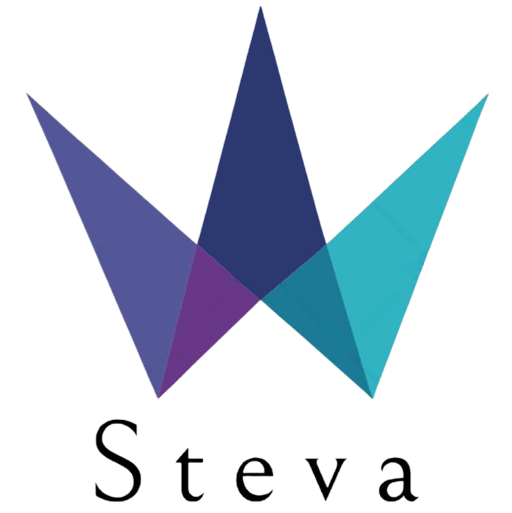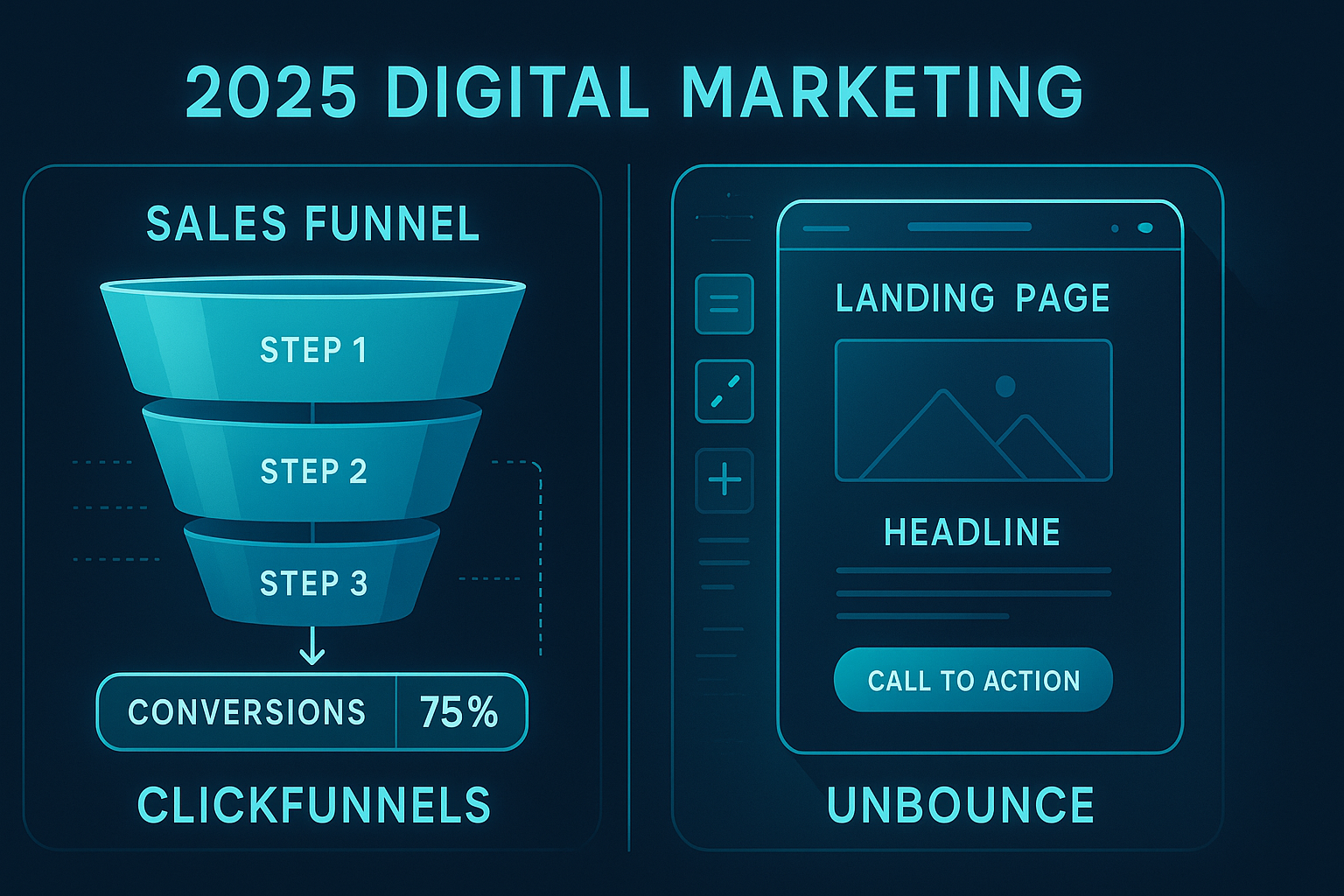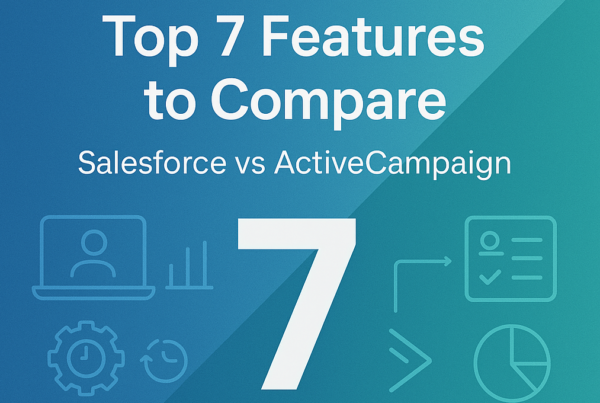Choosing ClickFunnels and Unbounce in 2025 boils down to each platform’s strengths. These tools help turn visitors into customers but serve different purposes. ClickFunnels builds detailed sales funnels that guide customers from discovery to purchase. Unbounce creates flexible landing pages that convert visitors effectively.
Your specific marketing goals should drive the decision between Unbounce competitors and the value of ClickFunnels. The debate between sales funnel builders vs. landing page builders focuses on what each does best. Unbounce’s Smart Traffic uses AI to send visitors to well-performing landing pages, which boosts conversions. ClickFunnels simplifies e-commerce with built-in shopping carts and order bump features that streamline payments. The price points differ, too; Unbounce costs $74 monthly, while ClickFunnels starts at $81 per month.
This detailed comparison will show you which platform fits your business needs in 2025. We’ve analyzed everything from core features to pricing structures to help you choose your marketing tech investment wisely.
Quick Summary: Who Wins? ClickFunnels or Unbounce?
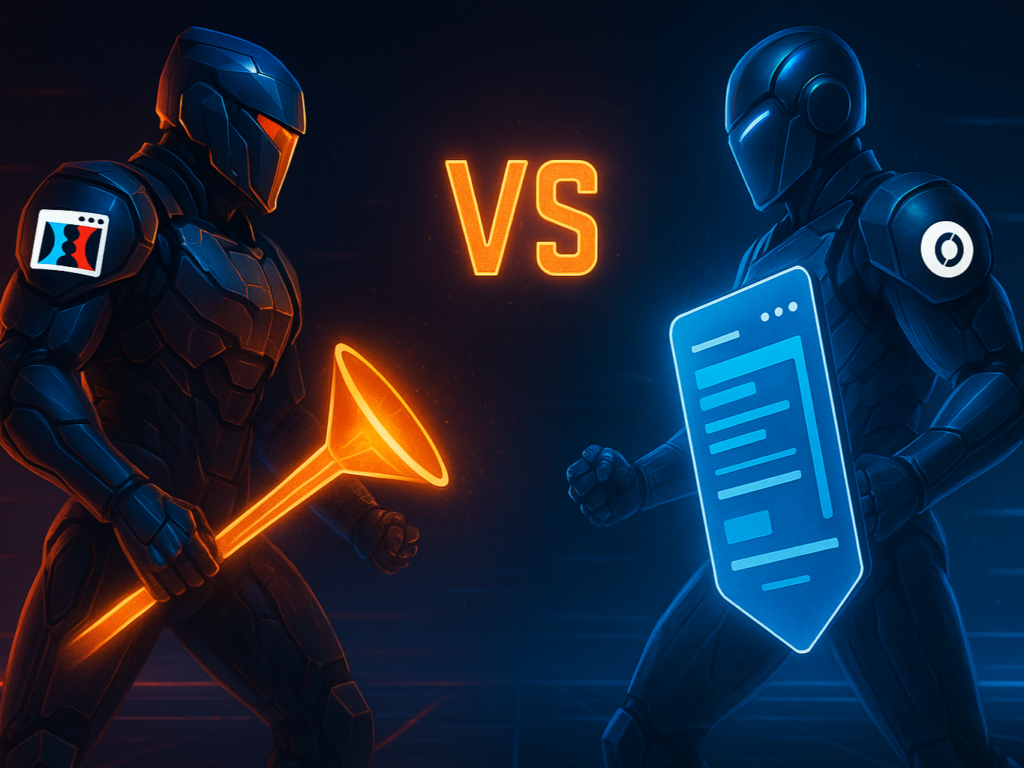
Need a quick answer in the ClickFunnels vs Unbounce debate? Your specific business needs and goals will determine the best choice. Each platform excels in unique areas that suit different marketing strategies.
ClickFunnels for end-to-end sales funnels; Unbounce for AI-optimized landing pages
These two powerful marketing tools serve different purposes. ClickFunnels is a complete sales funnel solution, while Unbounce leads in optimizing landing pages. ClickFunnels helps you build sales funnels that guide visitors through a well-laid buying experience. Unbounce creates high-converting standalone landing pages powered by AI technology.
1. Best for Sales Funnels: ClickFunnels
ClickFunnels stands out in sales funnel creation with its complete marketing package that builds full sales processes. Your funnel acts like your best salesperson and guides prospects through steps that build trust and show value. The platform lets you create upsells, downsells, and order bumps with a few clicks. Your business becomes an automated sales machine.
2. Best for Landing Pages: Unbounce
Unbounce leads the way in landing page excellence with its specialized approach. The drag-and-drop editor offers unlimited flexibility to place elements anywhere on your page. You get advanced A/B testing features in all pricing plans. Smart Traffic, Unbounce’s AI-powered conversion tool, routes visitors to landing page variants where they convert best. This results in 30% more sales and signups.
3. Best for Startups: Unbounce (cheaper entry)
Startups with limited budgets will find Unbounce’s pricing structure more appealing. Entry plans start at $74 monthly, while ClickFunnels costs $97 monthly. Unbounce’s easy-to-use interface works great for marketers who need to launch campaigns quickly without technical expertise.
4. Best for Scaling: ClickFunnels (membership sites, upsells)
ClickFunnels offers better scaling potential as your business grows. You can create recurring revenue through membership sites by packaging your knowledge into thriving communities. Members pay for exclusive access. These sites become hubs where your audience connects and grows together. ClickFunnels’ upsell features let you test new content ideas, offer premium upgrades, and track member engagement from one dashboard. It helps maximize your customers’ lifetime value during scaling.
Both platforms will keep evolving in 2025. Your choice should align with your primary goal: build complete sales funnels with ClickFunnels or create optimized landing pages with Unbounce. Many businesses start with one platform and add the other as their marketing needs become more complex.
Key Differences Between ClickFunnels and Unbounce
The actual differences between ClickFunnels and Unbounce go deeper than what meets the eye, which explains why each platform draws different types of users. You’d better choose between these tools by understanding their key differences based on your marketing goals in 2025.
1. Primary Use: Funnels vs Landing Pages
These platforms serve different purposes at their core. ClickFunnels builds sales funnels and connected pages that guide visitors through their buying trip. Picture having your best salesperson help prospects make decisions. Unbounce focuses on creating standalone landing pages that turn traffic into leads or customers. This difference between a sales funnel builder and a landing page builder is vital; ClickFunnels handles the complete customer experience, while Unbounce shines at optimizing specific conversion points.
2. Pricing: $97 vs $74 Starting Plans
Your budget plays a crucial role when choosing between these two platforms, especially if you’re starting your business journey.
- ClickFunnels starts at $97 monthly, offering 20 sales funnels, 100 pages, three payment gateways, and support for three domains.
- Unbounce begins at $74 per month, offering unlimited landing pages, sticky bars, popups, and helpful AI-driven copywriting features, too.
For startups or budget-conscious businesses, Unbounce provides more essential tools and better value while keeping conversion optimization a top priority.
3. AI Tools: Smart Traffic vs Basic A/B Testing
Unbounce leads ClickFunnels in AI-powered optimization, offering smarter tools to boost conversions with less manual work required.
- Unbounce Smart Traffic automatically sends visitors to the landing page versions where they’re most likely to convert efficiently.
- ClickFunnels, on the other hand, uses basic A/B testing methods that require manual tracking, tweaking, and optimization over time.
For paid ad campaigns, Unbounce’s AI-driven system significantly boosts ROI without needing constant adjustments or human oversight.
4. Checkout Features: Built-in vs Third-Party
When comparing e-commerce capabilities, each platform shines differently. ClickFunnels provides built-in sales tools, while Unbounce excels in custom design and requires integrations for processing payments and completing transactions.
- ClickFunnels: Comes with detailed built-in e-commerce features, including shopping cart functionality and order bump capabilities
- Unbounce: Creates highly customized checkout page designs but needs third-party integrations to process payments
Businesses focused on direct sales will find ClickFunnels’ native checkout features blend better without needing extra services.
5. Learning Curve: Funnel Logic vs Drag-and-Drop
Each platform offers a unique approach to ease of use. Unbounce focuses on intuitive drag-and-drop editing, while ClickFunnels simplifies multi-step funnel building with pre-built templates and guided workflows.
- ClickFunnels: Uses a structured approach focused on funnel logic and pre-designed sections. The platform “works differently than other software” and needs “more complexity.”
- Unbounce: Provides an easy-to-use drag-and-drop editor that lets you place elements anywhere on the page.
Beginners often adapt faster to Unbounce’s flexible editor, while ClickFunnels requires users to grasp funnel strategy concepts to tap into its full potential.
Your specific marketing objectives should guide your choice. ClickFunnels makes sense if you create detailed sales trips with integrated checkout processes. Unbounce might serve you better if you want to optimize individual landing pages with AI-powered tools.
Pricing and Value in 2025
The 2025 pricing models between ClickFunnels and Unbounce show key differences that could affect your choice based on your budget and business needs.
1. ClickFunnels Pricing 2025: Basic vs Pro Plans
ClickFunnels will keep its two-tier pricing structure simple in 2025. The Startup Plan costs $97 per month ($81 monthly with annual billing, which saves you $194 per year). This starter package has:
- 3 brand workspaces and 3 team members
- Unlimited funnels, pages, contacts, and domains
- Access to Funnel Hacker Forum and educational resources
Growing businesses consider the Pro Plan at $297 monthly ($248 with annual billing, saving $594 annually). You’ll get:
- 10 brand workspaces and 10 team members
- Priority support and weekly peer review hackathons
- All features of the Startup plan without limitations
You can try both plans free for 14 days and get a 30-day money-back guarantee. It gives you 44 days to test everything without risk.
2. Unbounce Pricing Tiers: Build, Experiment, Optimize
Unbounce comes with three main plans and great annual discounts. The Build Plan starts at $99 or $74 monthly with yearly billing (25% savings). You’ll get:
- Unlimited pages, popups ,and sticky bars
- Over 100 high-converting templates
- AI copywriting capabilities
The Experiment Plan is $149 monthly or $112 with annual billing. On top of the Build plan features, you get:
- Unlimited A/B testing variants
- Manual traffic allocation
- Confidence interval metrics
The Optimize Plan is perfect for advanced users at $249 monthly or $187 with an annual subscription. This detailed package has:
- All Experiment plan features
- Page, pop-up, and sticky bar scheduling
- Advanced targeting and industry standards
- Audience insights for deeper analytics
There’s also an Agency Plan with custom pricing for larger operations.
3. Hidden Costs: Email Automation, CRM Add-ons
Both platforms involve additional expenses beyond base pricing, including premium templates, third-party integrations, advanced analytics tools, and add-ons. These costs can add up depending on your marketing strategy and growth needs.
(i ClickFunnels’s additional costs:
- Email sending: $0.68 per 1,000 emails
- Email validation: $2.50 per 1,000 validations
- Video hosting: $0.10 per Video plus $10 for 1TB bandwidth
- Transaction fees: 2.9% + $0.30 per transaction through Payments.ai
- Integration runs: $0.01 per run (one-fourth of Zapier’s base price)
(ii) Unbounce additional considerations:
- Traffic limits: 20,000 visitors (Build), 30,000 (Experiment), 50,000 (Optimize)
- Professional services like onboarding, migration, and page redesign cost extra
4. Best Value for Startups vs Scaling Teams
- Startups and small businesses will find better value with Unbounce’s lower starting price ($74 vs $97 monthly with annual billing). You can create unlimited pages with conversion-focused tools without understanding complex funnel logic.
- Scaling businesses and established companies often get more value from ClickFunnels’ Pro plan despite its higher price. The unlimited features across workspaces, team collaboration tools, and integrated funnel building are a great way to get more for organizations with multiple products or services.
Your choice should depend on your main business goals rather than just price comparisons. One expert says, “The choice depends on your main business need, detailed funnel building versus specialized landing page optimization.”
Core Features Breakdown
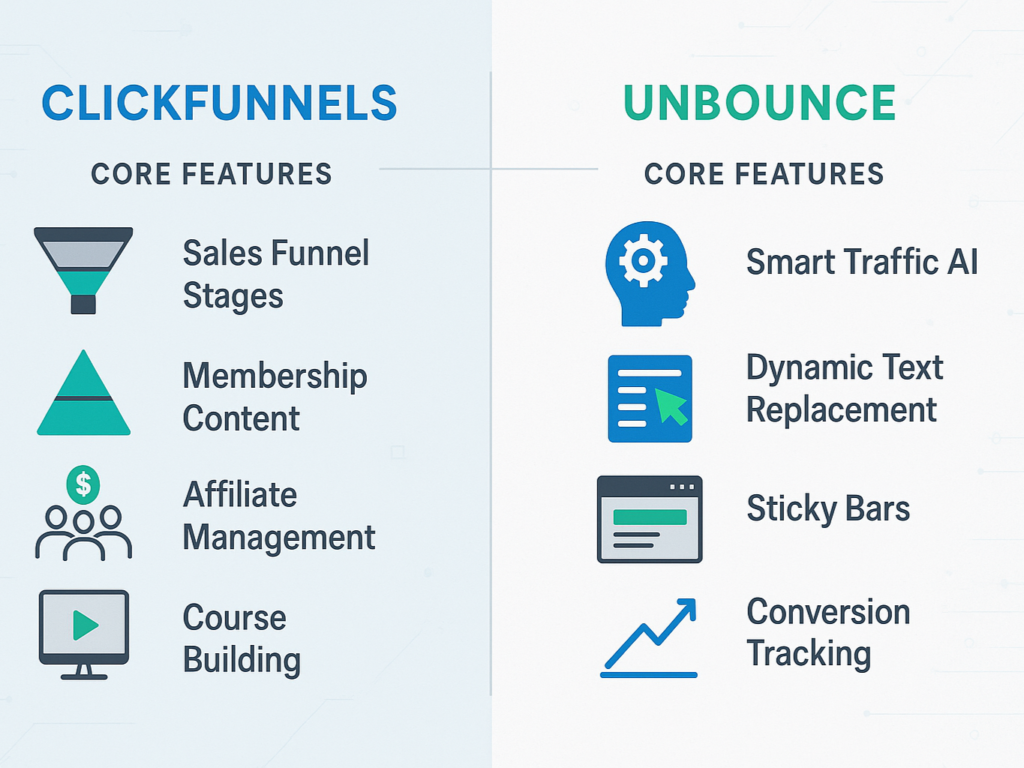
The core features of both platforms show substantial differences in their capabilities and strengths. Each tool has distinct functionality that serves different marketing objectives and strategies.
1. ClickFunnels: Funnel Stages, Memberships, Affiliate Tools
ClickFunnels is an all-in-one marketing platform that gives you everything you need to launch and grow an online business. The platform builds on its detailed funnel builder, which helps you create complete sales funnels that turn visitors into customers through strategic steps.
ClickFunnels has resilient membership site capabilities that create exclusive online communities around premium content. These membership areas do more than deliver content; they boost community “stickiness” and create recurring revenue. The platform lets you control content access based on purchase level. Restricted areas become visible only after customers buy specific products.
The Affiliate Center is a powerful feature that lets you create and manage your affiliate program inside ClickFunnels. This tool gives affiliates instant referral links, commission management, and promotional materials through a dedicated dashboard.
The platform also has an integrated course builder with features like drip scheduling and advanced user management. Course creators and online educators find this functionality valuable.
2. Unbounce: Smart Traffic, Dynamic Text, Sticky Bars
Unbounce Smart Traffic sets Unbounce apart.. This AI-powered conversion tool analyzes visitor attributes and routes them to landing page variants most likely to convert. Smart traffic optimizes faster than traditional A/B testing and makes split-second routing decisions based on visitor context. Users see an average 30% increase in conversions.
Dynamic Text Replacement (DTR) stands out as another powerful feature. It personalised landing page content by matching PPC ad copy to text on landing pages. This approach increases page relevance, improves conversion rates, and can enhance Google AdWords Quality Score. One user shared that DTR “significantly improved our ability to generate leads through PPC campaigns.”
Unbounce’s sticky bars and pop-ups can enhance any website page in minutes. These conversion tools come with sophisticated triggering options:
- Action-based triggers (arrival, abandonment, click, scroll)
- URL targeting
- Location and referral targeting
- Cookie-based targeting
3. Sales funnel builder vs landing page builder: Which suits your goal?
Your specific marketing objectives should guide your choice between these tools. ClickFunnels works best when you need to:
- Guide prospects through multiple conversion stages
- Add upsells, down sells, and order bumps
- Create membership sites with restricted access
- Manage affiliate programs
Unbounce shines when your priorities include the following:
- Maximizing conversion on specific landing pages
- Optimizing paid traffic campaigns with AI
- Personalizing content baseon the traffic source
- Creating highly customizable standalone pages
Yes, it is worth noting that “Funnels are strategic pathways designed to optimize the user journey through multiple steps, whereas landing pages focus on a single conversion goal.” Research shows websites often confuse visitors, while sales funnels serve a clear goal.
The choice between a sales funnel builder vs a landing page builder depends on whether you need a detailed customer experience (ClickFunnels) or highly optimized conversion points (Unbounce).
Ease of Use and Learning Curve
The user interface and learning curve of marketing platforms play a crucial role in your long-term commitment to a tool. A comparison between ClickFunnels and Unbounce shows key differences in their approach to user experience.
1. ClickFunnels: Funnel Logic and Template Flow
ClickFunnels uses a well-laid-out approach to page building. Users can customize pre-designed sections that simplify the design process but might restrict creative freedom. The platform gives you various funnel types, from lead generation to webinar registration, aligning with specific business goals.
Many users don’t call ClickFunnels user-friendly. Forbes Advisor states, “ClickFunnels is not a particularly intuitive platform… new users will need to invest the time and effort to learn how to use it to build effective funnels”. It creates an interesting situation: users stick with ClickFunnels despite not liking it much because they don’t want to rebuild their work elsewhere.
The platform has templates that cover almost every industry, “from real estate to B2B, ecommerce, SaaS… even dentistry and fitness”. Once you learn the simple funnel logic, these templates speed up the setup process.
2. Unbounce: Visual Editor and Fast Publishing
Unbounce stands out with its user-friendly drag-and-drop interface explicitly built for marketers. Users enjoy complete design freedom on the platform. A reviewer points out, “Unbounce doesn’t believe in restrictions, so it hands you the ability to place elements anywhere on your page.”
Publishing pages on Unbounce couldn’t be simpler. Their documentation states, “The quickest and surefire way to publish a page in Unbounce when you’re ready to launch is via the Page Overview… Wait a few moments, and that’s it; you’ve published your page, and it is now live!”. This simplicity runs through the entire platform’s design.
Unbounce boosts its usability with a mobile layout assistant. You can optimize desktop-designed pages for mobile devices with just one click, which is a must-have feature in today’s mobile-first world.
3. Which is more manageable for beginners?
Unbounce gives newcomers a smoother start in landing page creation. Its straightforward interface and visual editor make it available to users without technical expertise. Multiple sources confirm, “Unbounce is generally easier to learn, especially for beginners. Its drag-and-drop builder is very intuitive”.
ClickFunnels takes more time to master because it focuses on funnel strategy rather than design elements. The platform offers detailed educational resources, but you must understand funnel stages and conversion pathways to get the best results.
The main difference lies in their core purpose. Unbounce makes it easy to create standalone, optimized landing pages. ClickFunnels requires understanding how multiple pages work together in a conversion sequence.
Templates and Customization Options
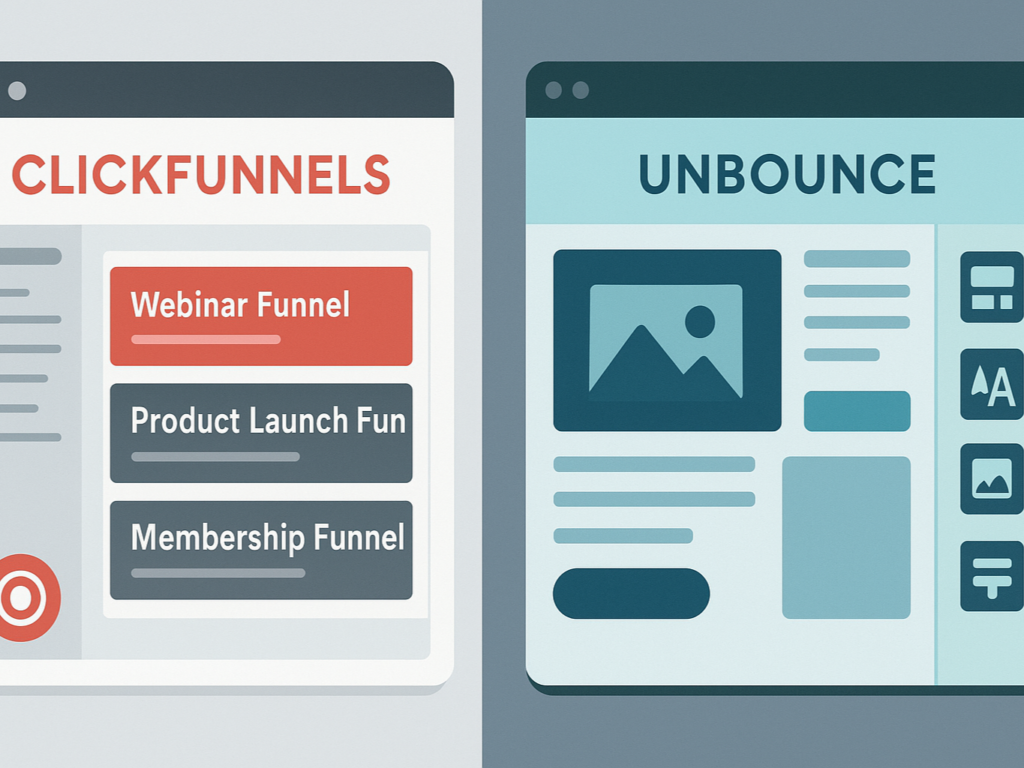
Marketing platforms’ template libraries and customization features shape how you launch campaigns that match your brand identity. ClickFunnels vs Unbounce both give you template options, but they take different approaches to flexibility and focus.
1. ClickFunnels: Funnel Templates for Webinars, Products
ClickFunnels focuses on funnel-specific templates that work toward conversion goals rather than standalone pages. Their template marketplace has ready-made funnels for webinars, product launches, memberships, and lead generation. These templates work as complete conversion paths instead of single pages.
ClickFunnels has specialized “Auto Webinar Funnels” templates that create structured paths from registration to replay access. Each template has logical page sequences that guide visitors toward specific conversion goals. A marketplace reviewer points out that these templates are “designed for marketers and companies who want to use a structured webinar funnel to convert leads effectively.”
The platform has many industry-specific options like “USD 0.00 JASON | Live Demo Funnel,” “USD 0.00 FOODIE | Hero Funnel,” and “USD 0.00 BREEZE | Membership Funnel”. While these templates don’t give you as much design freedom as Unbounce, they keep your branding consistent throughout multi-step funnels.
2. Unbounce: 150+ Landing Page Templates with Deep Customization
Unbounce takes a different approach, focusing on standalone page creation with more design flexibility. The platform has over 100 professionally designed, conversion-focused templates for all types of campaigns. You can use each template as a starting point and customize it with its drag-and-drop editor.
Unbounce templates use conversion-centered design principles that place elements strategically to guide visitor attention. Unlike ClickFunnels’ section-based editing, Unbounce gives you “complete freedom” in customization. You can place elements anywhere on the page.
The platform groups templates into click-through pages that send visitors to checkout flows and lead-generation pages that capture visitor information. This setup helps you find templates that match your conversion goals quickly.
3. Mobile Responsiveness and Design Flexibility
Both platforms ensure your designs work on mobile devices, though they handle it differently. Unbounce optimizes pages for mobile devices automatically to give users an uninterrupted experience on all screen sizes. Their mobile layout assistant can adapt desktop designs for smaller screens instantly.
The templates in both platforms show different philosophies. ClickFunnels templates work as guided funnel blueprints that reduce the risk of “leaky funnels,” while Unbounce templates give you creative freedom and detailed control.
Your choice depends on what matters most: Pick ClickFunnels for efficiency and guided conversion paths with consistent branding across funnel stages. Choose Unbounce if you need design flexibility and detailed customization of individual pages.
Integration Ecosystem
A strong integration ecosystem expands your marketing platform’s capabilities beyond its basic features. ClickFunnels vs Unbounce both connect with external tools. Their integration approaches mirror their core philosophies.
1. ClickFunnels: Stripe, PayPal, Zapier, Kajabi
ClickFunnels focuses on integrations that support detailed sales funnels. The platform connects with payment processors like Stripe and PayPal to handle transactions smoothly within funnels. Businesses can scale by connecting ClickFunnels with Kajabi, which links products to membership areas.
The platform provides specialized integrations such as:
- Twilio for individual-specific SMS messaging
- Calendar embedding to schedule appointments
- Shipstation and Disk Delivered to fulfill orders
- Salesforce to manage customer relationships
ClickFunnels’ official site states that it “integrates with all your essential tools, so everything works together.” It shows the platform’s commitment to building complete sales systems rather than individual pages.
2. Unbounce: HubSpot, Salesforce, Shopify, 200+ via Zapier
Unbounce employs a wider integration strategy by connecting with “more than 100 native integrations”. The platform combines thousands more through its strong Zapier connection. You can “power every stage of your marketing funnel with dozens of direct integrations.”
Key direct integrations include:
- CRM platforms like HubSpot and Salesforce
- E-commerce tools like Shopify
- Analytics services, including Google Analytics
- Email marketing systems such as Mailchimp
The platform’s official site highlights that users can “connect to over 5,000 apps without typing a single line of code” through Zapier. It gives marketers exceptional flexibility with various tech stacks.
3. Which platform supports more marketing tools?
Unbounce offers a larger integration ecosystem when it comes to connection options. The platform provides “200+ integrations via Zapier”. This number surpasses ClickFunnels’ limited third-party connections and gives businesses more flexibility when using multiple specialized tools.
ClickFunnels has stronger native integrations for specific uses. Direct connections with payment processors and membership platforms make it valuable, especially when you have sales-focused businesses.
Your integration needs to depend on your marketing strategy. Unbounce offers better flexibility if you use various marketing tools and need maximum connectivity. ClickFunnels provides simplified processes if you mainly build sales funnels with integrated payment processing. One expert notes, “The choice depends on your primary business need.”
Use Case Scenarios: When to Choose Each
The choice between these platforms becomes clearer as we explore specific business scenarios where each tool shines best. By understanding their ideal uses, you can pick the right solution that aligns with your marketing goals.
1. ClickFunnels: eCommerce, Courses, Affiliate Funnels
ClickFunnels stands out for businesses that need complete customer trip management. The platform’s built-in shopping cart, order bump features, and automatic sales tax collection through its native payment gateway, Payments AI, make it perfect for eCommerce operations. Physical product sellers with under 200 items will find it ideal for innovative checkout systems with upsells and order bumps.
Course creators love ClickFunnels because they can build and launch online courses quickly. The platform lets you “schedule courses to be published on specific dates and ‘drip’ content to your customers over time” using pre-designed templates.
Affiliate marketers can build detailed affiliate funnels with ClickFunnels’ specialized tools. The platform’s Affiliate Center lets you create and manage your affiliate program inside ClickFunnels. Affiliates get instant access to promotional assets and can track their performance easily.
2. Unbounce: PPC Campaigns, Lead Gen, Agency Work
Unbounce runs on targeted conversion scenarios. The platform works exceptionally well for PPC advertising campaigns as it helps “earn better Quality Scores from Google and lower your cost-per-click” through high-converting landing pages. Unbounce’s Dynamic Text Replacement switches headlines automatically to match search queries, which boosts relevance and performance.
The platform excels at lead generation by capturing visitor information through customizable forms. You can collect between one and twenty fields based on your needs. One customer achieved a remarkable “60% conversion rate” for their lead generation campaign.
Marketing agencies find great value in Unbounce’s feature, which lets them “manage multiple clients from a single account.” The platform uses domain-based pricing, so you only need to upgrade when adding new clients. Agencies can earn up to “35% recurring revenue” through their partner program and get co-marketing opportunities to grow their client base.
3. Real-life examples for each platform
Crazy Egg optimized its conversion process for its website optimization tool with ClickFunnels and increased its sales efficiency. Bonjoro employed ClickFunnels to boost its lead generation for its personalized welcome video app.
Vancouver Island University’s “Worth It” campaign used Unbounce effectively. The campaign addressed student concerns about tuition costs and generated qualified educational leads.
Pros and Cons: Click Funnels vs. Unbounce
Let’s break down both platforms’ specific strengths and weaknesses to help you choose wisely for your marketing needs.
1. ClickFunnels Pros and Cons
Pros:
- All-in-one solution: ClickFunnels gives you a detailed marketing platform with everything you need to launch and grow an online business.
- Expert-designed templates: Their funnel templates have proven success rates backed by data from thousands of users.
- Built-in payment processing: Direct integration with payment gateways removes the need for third-party tools.
- Affiliate management: Ready-to-use tools that help create and manage your affiliate program.
- Regular feature updates: The platform keeps adding new capabilities.
Cons:
- Higher pricing: Many users find the pricing plans expensive compared to competitors.
- Work-in-progress platform: Active development might cause occasional glitches.
- Feature generalization: The platform tries to do too much, which can affect specialization.
- Technical issues: Users have reported bugs in various features.
- Limited SEO capabilities: Not the best choice for search engine optimization.
2. Unbounce Pros and Cons
Pros:
- User-friendly drag-and-drop editor: You don’t need coding knowledge to create landing pages.
- AI-powered optimization: Smart Traffic sends visitors to the best-performing page variants automatically.
- Advanced A/B testing: You can test different versions to find the best.
- Mobile responsiveness: Pages look great on all devices.
- Rich integration ecosystem: Works with over 200 tools, including major CRM platforms.
Cons:
- Learning curve: New users might need time to get used to all the tools.
- Template limitations: Some users say customization options are restricted.
- Integration constraints: Not all third-party tools blend well.
- Price point concerns: Other landing page builders cost less.
- Slow feature adoption: New capabilities take time to implement.
Your choice depends on your marketing goals. ClickFunnels gives you detailed sales funnel tools at a higher price, while Unbounce offers excellent landing page optimization with AI features at a lower starting price.
ClickFunnels vs Unbounce: Complete Comparison Guide for 2025
| Feature/Aspect | ClickFunnels | Unbounce |
| Starting Price | $97/month ($81 with annual billing) | $74/month (with annual billing) |
| Main Focus | Complete sales funnels | Standalone landing pages |
| Core Strength | End-to-end sales process automation | AI-optimized landing page conversion |
| AI Capabilities | Simple A/B testing | Smart Traffic AI optimization (30% more conversions) |
| Page Limits | Unlimited funnels and pages (Startup Plan) | Unlimited pages, popups, sticky bars |
| E-commerce Features | Built-in shopping cart and order bumps | Requires third-party integrations |
| Editor Type | Section-based with funnel logic | Drag-and-drop with complete design freedom |
| Learning Curve | Steeper, requires funnel strategy understanding | Easy-to-use, beginner-friendly |
| Integration Options | Limited native integrations | 200+ integrations via Zapier |
| Best Suited For | E-commerce operations, Course creators, Affiliate marketers | PPC campaigns, Lead generation, Agency work |
| Additional Costs | Email: $0.68/1,000 emails, Email validation: $2.50/1,000, Video hosting: $0.10/video [24-26] | Professional services for onboarding and migration |
| Traffic Limits | Not mentioned | Build: 20,000 visitorsExperiment: 30,000 visitorsOptimize: 50,000 visitors |
Final Verdict: Making the Right Choice in 2025
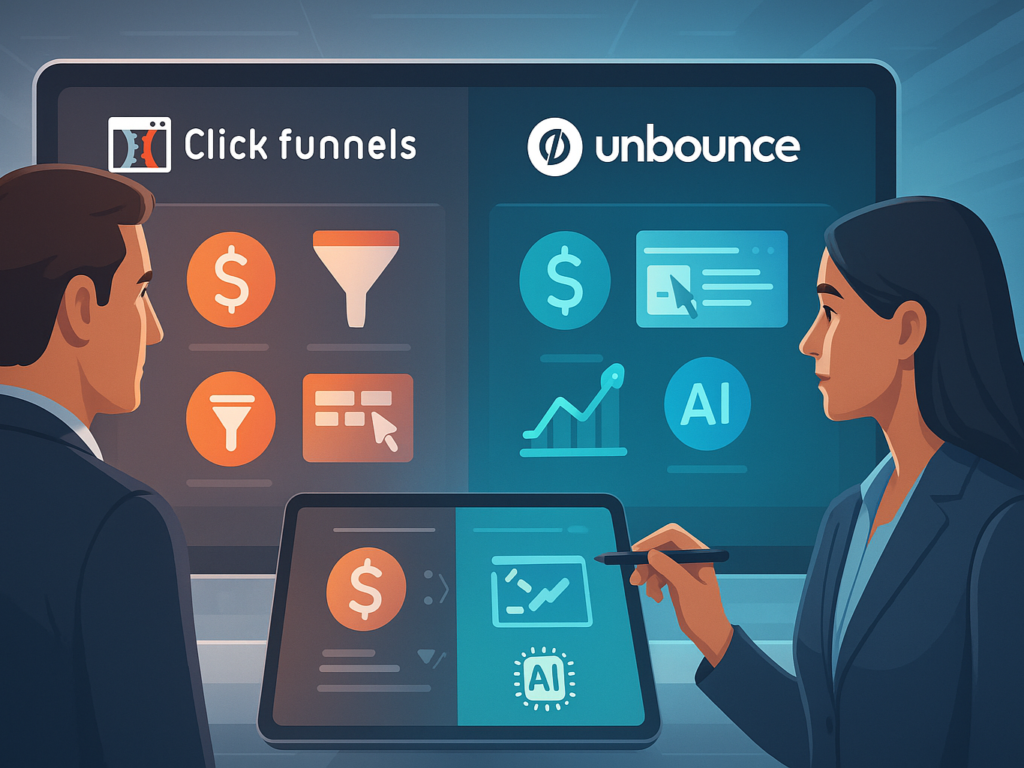
Choosing between ClickFunnels and Unbounce comes down to your business goals. ClickFunnels is ideal for creating complete sales experiences with upsells, downsells, and built-in checkouts. It benefits knowledge entrepreneurs and course creators who want to generate recurring income. On the other hand, Unbounce focuses on landing page optimization, using Unbounce Smart Traffic technology that can boost conversions by 30%.
Unbounce is more affordable for small businesses and beginners, starting at $74/month compared to ClickFunnels’ $97/month (with annual billing). It offers more design freedom and is easier to learn, but lacks direct payment processing. ClickFunnels costs more but supports unlimited funnels and advanced features that suit growing businesses with multiple products.
Many successful marketers use both. Unbounce handles landing page optimization, while ClickFunnels manages the sales journey. Both platforms offer free trials, so it’s worth trying each to see which aligns better with your goals and growth strategy.
FAQs on clickfunnels vs unbounce
Q1. Can Unbounce build sales funnels?
No, Unbounce focuses on creating individual landing pages rather than full funnel experiences. If you compare a Sales funnel builder with a landing page builder, ClickFunnels is the better choice for complex funnels. Unbounce is great for optimization, but for guiding leads through multiple steps, ClickFunnels is your go-to.
Q2. Is ClickFunnels worth the high price?
ClickFunnels offers a complete suite for entrepreneurs needing upsells, memberships, and automation. When you break down ClickFunnels pricing 2025, the value depends on your needs. It’s worth it for serious marketers building complex sales funnels, but overkill for simple campaigns. Consider your goals and use case before committing to its premium pricing.
Q3. Which has better A/B testing: ClickFunnels or Unbounce?
Unbounce leads here thanks to Unbounce Smart Traffic, which automatically routes visitors to the best-performing landing page. ClickFunnels still uses basic split-testing, which requires manual tweaks. If testing performance matters, Unbounce’s AI technology can give you better conversion gains with less effort, making it a more intelligent choice for optimization-focused marketers.
